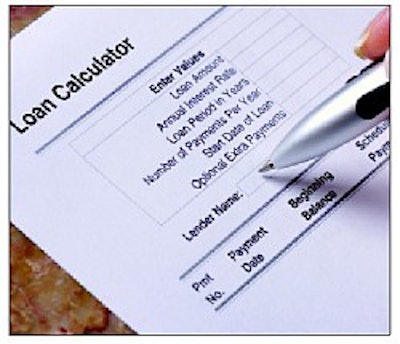

—he's seen plenty of other contracting companies in his area go out of business by taking out loans to finance fancy showrooms and buy top-of-the-line company vehicles. But Javier is having difficulty getting ahead because he lacks the capital for new equipment, advertising to promote his company and reliable transportation.
At some point, most business owners will be faced with the question of whether or not they should borrow money for their business. While some may caution against borrowing—and most would agree that excessive debt should be avoided—the answer to this question isn't necessarily a resounding "no." Used wisely, debt can be a valuable tool to help you grow your business.
"Every small business I've ever known has had to borrow money at some point," says Jim Blasingame, host of the nationally syndicated radio and Internet program "The Small Business Advocate" and author of the book Small Business Is Like A Bunch Of Bananas. "Borrowing money for your business is not a bad thing to do, but it must be done judiciously."
Good Versus Bad Debt
So, how do you know what is "good" debt versus "bad" debt? According to Blasingame, the biggest mistake most small businesses make when it comes to debt is in their allocation of borrowed funds. In other words, how you use debt is just as important as whether or not you borrow money in the first place.
In general, Blasingame explains, it's a good idea to borrow to finance capital items (showrooms, machines, company vans) that you will use for more than a couple of years—even if you have the cash to pay for them. "You don't want to deplete your operating cash to buy large capital items," Blasingame says. "When you finance capital expenditures, this frees up your operating cash flow to fund the day-today working capital expenditures of your business or take advantage of other opportunities, like maybe investing in training or purchasing additional inventory at a good price."
Put another way, operating cash should be used for capital to run your business, not as capitalization to purchase long-term assets. These are usually better financed via a bank term loan, which should be structured to match the useful life of the asset being financed. For example, if you're borrowing to finance high-tech equipment that you expect to last three to four years, you wouldn't want to pay for it with a five-year term loan.
Jim Horan, president of The One Page Business Plan Company and author of the best-selling book The One Page Business Plan, agrees. "It's fine to borrow money for capital expenditures," Horan says. "But before borrowing, a company should have a solid business plan in place with strong financials. The owner needs to think through how the money will be repaid and understand the potential impact of servicing the debt on cash flow and the bottom line."
Or, as Blasingame puts it, "Borrowed money accrues interest to the lender and must be repaid, which creates an incremental drain on the company's liquidity. The business has to be able to generate the cash flow to make these payments. And the only way to know whether or not this is feasible is to build a yearly cash-flow model based on your operating statement."
Such a cash-flow model can be used to help you see if your business can generate enough cash flow to service debt. Aside from servicing a loan, it can also help you see if there will be any temporary cash-flow shortfalls throughout the year. This leads into the second primary use of debt for small businesses: funding working capital, or daily operating expenses.
"Your cash-flow model will give you a picture of your projected cash position at the end of each month for the next 12 months, so you can clearly see when you'll need cash and for how long," Blasingame says. For each month, project your income and expenses and estimate how long it will take to collect receivables versus how quickly you'll have to pay your invoices (the difference here defines your cash-flow cycle). Now, plot all this on a 12-month financial timeline. "A negative number at the end of any month represents a working capital shortfall you'll need to make up via debt, investment capital or retained earnings in the business," Blasingame explains.
To cover this type of cash shortfall, you may apply for a short-term working capital loan or a line of credit. A line of credit is one of the most common and useful financing tools used by small businesses. It allows you to borrow funds as needed to meet routine operating expenses and working capital needs or cover temporary cash shortfalls. Once approved, you can borrow up to your predetermined credit limit at any time, usually by simply writing a check. A homeequity line of credit (HELOC), secured by the equity in your principal residence, is an attractive option for an increasing number of self-employed professionals and for those just starting a business.
Alternatives to Debt
While debt may be preferred for funding capital expenses, it shouldn't be viewed as an easy fallback for bad financial management or wasteful spending. Before heading to your banker for a loan to cover cash shortfalls, first look for ways to manage your finances more efficiently or maybe even cut costs.
"Bootstrapping" is a term used to describe generating more cash within your business by doing just this. For starters, Horan says, tighten your credit and collection policies and stretch out your payables as far as possible (within your vendors' terms) to shorten your cash-flow cycle.
"Shortening your cash-flow cycle by 10 to 15 days could eliminate the need for short-term financing completely," Horan says. "Also, take a close look at what might be frivolous or wasteful expenses. A top-of-the-line showroom may be nice, but for now, the overhead costs could outweigh the benefits it could bring.
"Make sure you're charging enough for your services," Horan adds. He notes that self-employed professionals, especially those just starting out, tend to undercharge for fear of losing business. "Find out the standard rates and terms in your industry, and don't hesitate to ask for half of a project upfront. Not only can this provide a big boost to cash flow, but it also is a good indication that your client actually has the money to pay you."
Blasingame offers another caution: "Be careful not to grow yourself out of business. Success begets growth, and growth adds tremendous pressure to your working capital. Leverage can be a wonderful tool for a small business, but you can't borrow yourself into success. You have to be able to fund your cash-flow cycle, and if this means borrowing, you have to be able to service your debt. If you can't, it's entrepreneurial suicide."
Horan offers a few more words of wisdom when it comes to small-business debt:
• Don't borrow to pay your salary.
• Don't make permanent investments in equipment if you can borrow or lease the equipment.
• Be careful about assuming debt if you're in a new business partnership.
• Don't borrow more money than you can reasonably expect to repay.
How Much is Too Much?
With the right information in hand, your banker can help you determine how much you may need to borrow and the best way to structure the debt. Before approaching your banker with a loan request, do your homework by making sure your business plan is current, you have a good idea of why you need to borrow money, you are prepared to discuss collateral and you've prepared a cash-flow model.
"Entrepreneurs are optimistic by nature, but you can never expect your banker's zeal to match your own," Blasingame cautions. "Also, you must keep your banker informed, of both good news and bad. Remember this: An uninformed banker is a scared banker—and no one ever got any help from a scared banker."
Types of Business Loans
The most common types of small business loans include the following:
• Line of credit: Allows you to borrow funds as needed to meet short-term operating expenses and working capital needs or cover temporary cash shortfalls. Once approved, you can borrow up to your predetermined credit limit at any time, usually simply by writing a check. May be secured (by collateral) or unsecured, with home equity lines of credit becoming increasingly common for home-based entrepreneurs.
• Term loan: A loan of a specific amount of money, usually at a fixed interest rate and with a fixed repayment term. May be short (less than one or two years) or long term, and usually made for a specific purpose, such as to finance equipment, property, acquisitions or major business expansion. Repayment schedule will be structured to match the useful life of the asset being financed.
• Construction loan: A long-term loan used specifically to finance the purchase of land and construction of owner-occupied buildings or investment property.
• Government loan programs: A variety of state and federal programs can help small businesses secure financing. The Small Business Administration (SBA) helps banks make loans to businesses that might not qualify for traditional commercial financing. Through the SBA's MicroLoan program, for example, small firms can secure short-term loans of up to $35,000.
• Credit cards: Their wide availability makes credit cards an increasingly common source of financing for small and start-up firms. Business credit cards offer helpful features such as detailed financial reports and extensive business and travel services. However, credit cards do carry interest and finance charges, so use them sparingly and make an effort to pay more than the minimum amount each month.
































